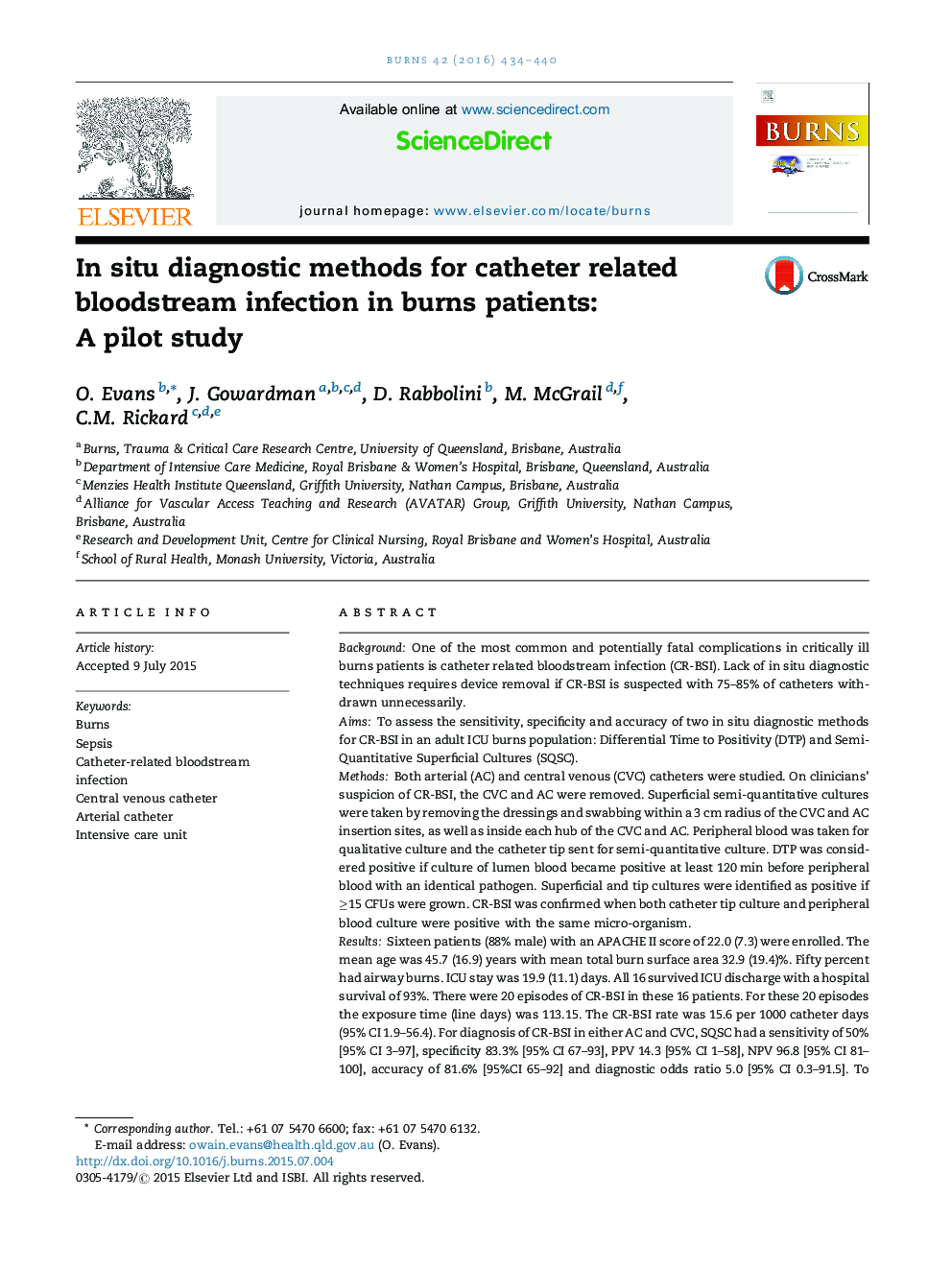| کد مقاله | کد نشریه | سال انتشار | مقاله انگلیسی | نسخه تمام متن |
|---|---|---|---|---|
| 3104052 | 1191639 | 2016 | 7 صفحه PDF | دانلود رایگان |
• In situ techniques for evaluating CR-BSI in burns patients were studied.
• The CR-BSI rate was 15.6 per 1000 catheter days.
• Differential time to positivity had a specificity of 97% and sensitivity of 50%.
• Semi-quantitative skin culture had a specificity of 83.3% and sensitivity of 50%.
• In situ diagnostic methods may support watchful waiting in suspected CR-BSI.
BackgroundOne of the most common and potentially fatal complications in critically ill burns patients is catheter related bloodstream infection (CR-BSI). Lack of in situ diagnostic techniques requires device removal if CR-BSI is suspected with 75–85% of catheters withdrawn unnecessarily.AimsTo assess the sensitivity, specificity and accuracy of two in situ diagnostic methods for CR-BSI in an adult ICU burns population: Differential Time to Positivity (DTP) and Semi-Quantitative Superficial Cultures (SQSC).MethodsBoth arterial (AC) and central venous (CVC) catheters were studied. On clinicians’ suspicion of CR-BSI, the CVC and AC were removed. Superficial semi-quantitative cultures were taken by removing the dressings and swabbing within a 3 cm radius of the CVC and AC insertion sites, as well as inside each hub of the CVC and AC. Peripheral blood was taken for qualitative culture and the catheter tip sent for semi-quantitative culture. DTP was considered positive if culture of lumen blood became positive at least 120 min before peripheral blood with an identical pathogen. Superficial and tip cultures were identified as positive if ≥15 CFUs were grown. CR-BSI was confirmed when both catheter tip culture and peripheral blood culture were positive with the same micro-organism.ResultsSixteen patients (88% male) with an APACHE II score of 22.0 (7.3) were enrolled. The mean age was 45.7 (16.9) years with mean total burn surface area 32.9 (19.4)%. Fifty percent had airway burns. ICU stay was 19.9 (11.1) days. All 16 survived ICU discharge with a hospital survival of 93%. There were 20 episodes of CR-BSI in these 16 patients. For these 20 episodes the exposure time (line days) was 113.15. The CR-BSI rate was 15.6 per 1000 catheter days (95% CI 1.9–56.4). For diagnosis of CR-BSI in either AC and CVC, SQSC had a sensitivity of 50% [95% CI 3–97], specificity 83.3% [95% CI 67–93], PPV 14.3 [95% CI 1–58], NPV 96.8 [95% CI 81–100], accuracy of 81.6% [95%CI 65–92] and diagnostic odds ratio 5.0 [95% CI 0.3–91.5]. To diagnose tip colonisation (>15CFU), sensitivity of SQSC was 75% [95% CI 22–99], specificity 88.2% [95%CI 72–96], PPV 42.7 [95% CI 12–80], NPV96.8% [95% CI 81–100], accuracy 86.8% [95% CI 71–95] and diagnostic odds ratio 22.5 [95% CI 1.9–271.9]. For combined DTP blood cultures, sensitivity for CR-BSI was 50% [95% CI 3–97], with specificity 97% [95% CI 82–100], PPV 50% [5% CI 3–97%], NPV 97% [95% CI 82–100], accuracy 94.3% 95% CI 79–99] and diagnostic odds ratio 32 [95% CI 1.1–970.8].ConclusionBoth DTP and SQSC displayed high specificity, NPV and accuracy in a population of adult burns patients. These features may make these tests useful for ruling out CR-BSI in this patient group. This study was limited by a low number of events and further research is required.
Journal: Burns - Volume 42, Issue 2, March 2016, Pages 434–440
